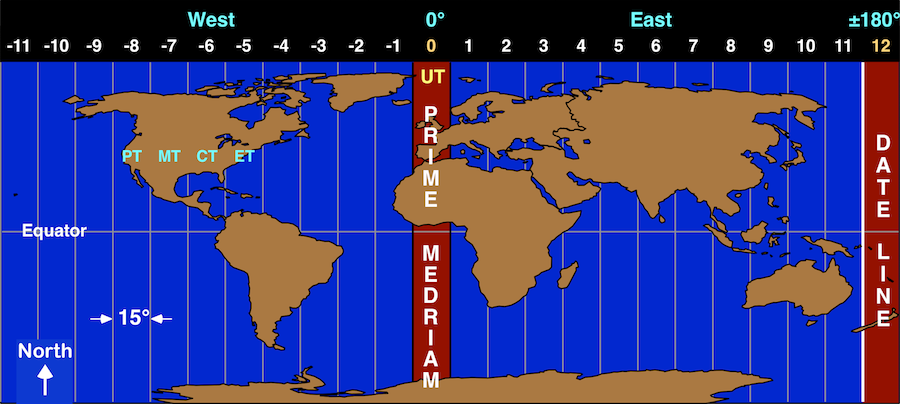Coordinated Universal Time (UTC)
Greenwich England Time
Coordinated Universal Time (UTC) is also called International Time, Universal Time (UT), Zulu Time or Greenwich Mean Time (GMT). GMT was established by international conference in 1884. It’s based on the local time in Greenwich England, sun's peak is set to noon.
Twenty Four Hour Time
Twenty Four Hour time is used with Universal or Local time and does not use "am" or "pm", it courts hours from midnight (0 hours) to 11 pm (23 hours).
TIME
AM / PM
and 24 Hour
| AM |
Hours |
| 12 |
00 |
| 1 |
01 |
| 2 |
02 |
| 3 |
03 |
| 4 |
04 |
| 5 |
05 |
| 6 |
06 |
| 7 |
07 |
| 8 |
08 |
| 9 |
09 |
| 10 |
10 |
| 11 |
11 |
-
| PM |
Hours |
| 12 |
12 |
| 1 |
13 |
| 2 |
14 |
| 3 |
15 |
| 4 |
16 |
| 5 |
17 |
| 6 |
18 |
| 7 |
19 |
| 8 |
20 |
| 9 |
21 |
| 10 |
22 |
| 11 |
23 |
The earth is divided into 24 time zones, -11 to +12. Each time zone is 1 hour long, or 15° wide in longitude. Greenwich England is, by definition, in the middle of Time Zone 0, the prime meridian. UTC time is the local time at Greenwich England. Time in other locations will be the UTC time hour plus or minus the local Time Zone.
Time Around the World
Time Zone & Local Standard Time
| -11 |
-10 |
-9 |
-8
PST
|
-7
MST
|
-6
CST
|
-5
EST
|
-4 |
-3 |
-2 |
-1 |
UT
0
|
+1 |
+2 |
+3 |
+4 |
+5 |
+6 |
+7 |
+8 |
+9 |
+10 |
+11 |
+12 |
|
|
|
|
|
|
|
|
|
|
|
|
|
| |
| |
| |
| |
| |
|

Hours behind (-), or ahead of, UT
EST - Eastern Standard Time
CST - Central Standard Time
MST - Mountain Standard Time
PST - Pacific Standard Time
|
Daylight savings time (DST) is used in the summer months in some regions. DST is 1 hour ahead of standard (real) time. There is no consistency between regions as to when DST takes affect, or reverts back to standard (real) time. DST was never practical and will eventually be phased out.
World Standard Time
|
|
|
-8
Pacific (PST)
San Franciso
|
|
|
|
-7
Mountain (MST)
Phoenix, Denver
|
|
|
|
-6
Central (CST)
St Louis
|
|
|
|
-5
Eastern (EST)
New York
|
|
|
|
|
|
-3
Greenland
RioDeJaneiro
|
|
|
|
|
|
|
|
+2
Jerusalem
Cairo, Istanbul
|
|
|
|
|
|
|
|
|
|
|
|
|
|
|
|
DEFINITIONS
- Mean Solar Time --
a measurement of the Earth's rotation with respect to the fictitious mean sun.
- Atomic Clock --
Measures seconds based on the frequency of the cesium 133 atom (Cs) oscillation.
- Second -- Based based on the duration of 9,192,631,770 periods of radiation corresponding to the transition between the two hyperfine levels of the ground state of the Cesium 133 atom (Cs).
- Mean Solar Time --
a measurement of the Earth's rotation with respect to the fictitious mean sun.
- UT --
Universal Time is widely used and based on the average of multiple atomic clocks, UT0, UT1, UT2, and UTC.
- UT0 -- Mean Solar Time on the Greenwich meridian obtained from direct astronomical observation. The time 00 hours being at Greenwich mean midnight.
- UT1 -- UT0 corrected for polar motion (widely used).
- UT2 -- UT1 corrected for seasonal variation in the Earth's rotation (a smoothed scale that does not reflect the real periodic variations in the Earth's angular position).
- UTC -- Civil atomic time scale on or about the Greenwich meridian kept within 0.9 seconds of UT1.
REFERENCE: A Briefer History of Time -- Howard Barnes, Georgi Dobrovolski Solar Observatory, New Zealand, 2010. (PDF version)
Standard Date Format
Virtually the entire world formats time as Hours:Minutes:Seconds. The date format
Year-Month-Day
has become widely accepted as a standard in many countries.
Year Month Day
International Standard ISO 8601,
United States ANSI X3.30 and NIST FIPS 4-1,
Canadian standard CSA Z234.5,
European standard EN 28601,
British standard BS EN 28601.
Year 2000
The United States and many other countries use the Christian Gregorian calendar to mark years. This calendar has become a standard in such worldwide industries as aviation, and international commerce and trade -- however, other calendars do exist.
CALENDAR YEAR
Jewish 5760-5761
Chinese 4698 (Year of the Dragon)
Old Roman 2753
Buddhist 2544
Christian 2000
Coptic 1716
Islamic 1420-1421
|
Coordinated Universal Time
CopRadar.com/utctime

